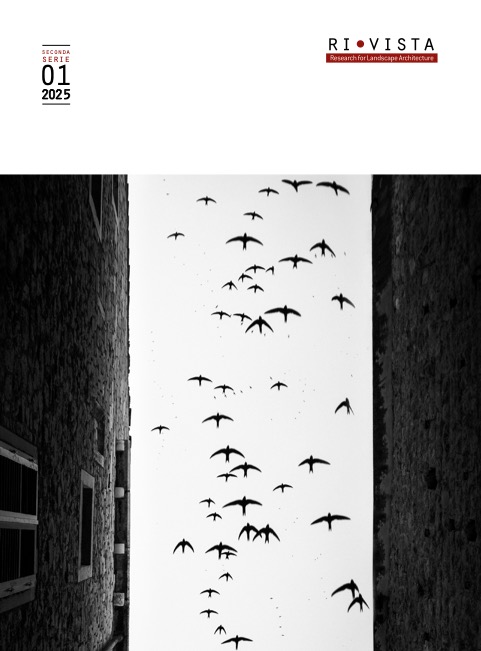Agrarian voids as dynamic spaces in the contemporary city. The historic orchards of Nerja, Malaga
Published 2025-10-28
Keywords
- productive landscape,
- agriculture and city,
- orchard huerta,
- dynamic cartography
How to Cite
Copyright (c) 2025 Celia Chacón Carretón, Mar Loren-Méndez, Pablo Millán-Millán

This work is licensed under a Creative Commons Attribution 4.0 International License.
Abstract
Agriculture and architecture are realities in continuous dialogue in many territories where the productive landscape is an inherent part of the built environment, especially those on a smaller scale with an immediate presence in the city, such as the orchards, which has been attacked by urban development, causing a fracture detrimental to historical logic. Through a detailed typological study of the orchards of Nerja, Malaga, this research places these lands at the center of the narrative, providing a historical analysis that addresses the uniqueness and idiosyncrasy of the orchard as a holistic space, both agricultural and urban. Using a methodology that combines the study of the historical dimension and the unprecedented contemporary drawing of the orchard in its complexity, the potential and urgency of these agrarian voids in the contemporary city is confirmed. Forgotten and marginal redoubts, whose informal presence currently represents the dynamic, spontaneity and identity-driven escapism of Nerja and its inhabitants.
References
- Almarcegui L. 2003, Demolitions, wastelands, allotment gardens. Établissements d'en Face, Bruxelles.
- Batlle E. 2011, El jardín de la metrópoli. Del paisaje romántico al espacio libre para una ciudad sostenible, Gustavo Gili, Barcelona.
- Calatayud Giner S. 2005, La ciudad y la huerta, «Historia Agraria», n. 35, pp. 145–164 https://historiaagraria.com/en/issues/salvador-calatayud-giner-la-ciudad-y-la-huerta
- Capilla Luque F. 2006, El Castillo Bajo de Nerja (1502-1811). Origen y evolución de una fortaleza desaparecida, «Boletín de Arte, Universidad de Málaga», n. 26–27(1), pp. 93–116 https://doi.org/10.24310/BoLArte.2006.v0i26-27.4545 DOI: https://doi.org/10.24310/BoLArte.2006.v0i26-27.4545
- Capilla Luque F. 2016, La industria azucarera en Nerja y Maro. Las fábricas, Libros de la Axarquía, Colección Monografías, Vélez-Málaga.
- Chacón-Carretón C., Loren-Méndez, M. & Millán-Millán, P. 2024, Dynamic Cartography for Landscape Representation of Agricultural Heritage. In: Hermida González L., Pedro Xavier J., Pernas Alonso I. & Losada Pérez C. (eds.) 2024, Graphic Horizons, Springer, Zurich. https://doi.org/10.1007/978-3-031-57579-2_25 DOI: https://doi.org/10.1007/978-3-031-57579-2_25
- Clément G. 2004, Manifesto of the Third Landscape, Pandora, Paris.
- Corboz A. 1980, El territorio como palimpsesto. In: Ramos A.M. (ed.) 1980, Lo urbano en 20 autores contemporáneos, Ediciones UPC, Barcelona.
- Donadieu, P. 2006. Campagne urbane. Una nuova proposta di paesaggio della città, Donzelli, Roma.
- Donadieu, P. 2015. Les campagnes urbaines: quels scénarios pour demain?, «Ri-Vista. Research for Landscape Architecture», n. 10(2), pp. 50–57. https://doi.org/10.13128/RV-17247
- Folch R. 1990, Que lo hermoso sea poderoso, Alta Fulla, Barcelona.
- Koohafkan, P. & Altieri M. A. 2016, Forgotten Agricultural Heritage: Reconnecting Food Systems and Sustainable Development, Routledge, London. DOI: https://doi.org/10.4324/9781315470092
- Koolhaas R. 2020, Countryside. A Report, Guggenheim-Taschen, Köln.
- Laborit H. 1974, La nouvelle grille, Robert Laffont, Paris.
- Latouch S. 2009, Farewell to growth, Polity, Cambridge.
- Mata Olmo R. 2010, La dimensión patrimonial del paisaje. Una mirada desde los espacios rurales. In: Maderuelo J. (ed.) Paisaje y patrimonio, Abada, Madrid.
- Magnaghi A. 2010, Il progetto locale. Verso la coscienza di luogo. Bollati Boringhieri, Torino.
- Meadows D. H., Meadows D. L., Randers J. & Behrens W. W. 1972, The limits of growth, MIT Potomac Associates, Virginia.
- Meeus Johan. H. A., Wijermans M. Pierre. & Vroom Meto. J. 1990, Agricultural landscapes in Europe and their transformation, «Landscape Urban Plan», n. 18, pp. 289–352. https://doi.org/10.1016/0169-2046(90)90016-U DOI: https://doi.org/10.1016/0169-2046(90)90016-U
- Niles D. 2018, Agricultural Heritage and Conservation Beyond the Anthropocene. In: Labrado A. M. & Silberman N. A. (eds.) 2018, The Oxford Handbook of Public Heritage Theory and Practice, Oxford, Oxford University Press. DOI: https://doi.org/10.1093/oxfordhb/9780190676315.013.2
- Secchi B. 1984, Le condizioni sono cambiate, «Casabella», n. 498–499, pp. 8–13. DOI: https://doi.org/10.1016/0302-4598(84)87059-2
- Solà Morales I. 1995, Terrain vague. In: Solá Morales I. (ed.) 2000, Territorios, Gustavo Gili, Barcelona.





